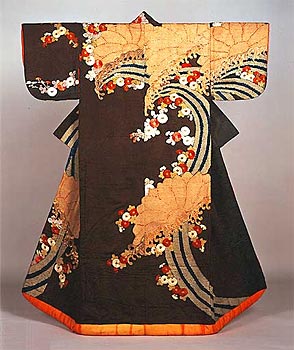| kimonos
Furisode
In addition to the traditional screens, scrolls, lacquerware, and ceramics (and a few “modern” paintings), a variety of kimono were displayed. My interest in kimono is comparatively recent—when I was younger I would have foolishly dismissed kimono as “craft” rather than “real art”. But a 1998 exhibition of ukiyo-e and kimono at the National Gallery of Australia—titled Beauty and Desire in Edo Period Japan—cured my ignorance.
Most of the kimono in the current exhibition are kosode, the traditional name for what is regarded nowadays as a typical kimono. The kosode, whose name comprises the characters for “small” and “sleeve”, is more practical than the long-sleeved furisode.
[more]
Edo à la Mode
- Aesthetic Lineages Seen in Kosode Kimono Motifs -
KOSODE kimono is the traditional name for what is today considered an ordinary kimono. Compared to the long-sleeved forms of traditional court kimono, such as the sokutai and the hitatare, the KOSODE is fitted with short practical sleeves that give it its name. KOSODE began to be used as robe (top-wear) during Japan's medieval period, and it rapidly entered the fashion limelight in the Edo period. The urban middle classes of the early Edo period, who were the major players in the fashion trends, brought the unusual or bizarre dress of courtesans and kabukimono (outlaws) into town fashions, and in the later Edo period, the trend of fashions changed towards the elegant and chic.

Kosode with Chrysanthemums and Flowing Water;
Tie-dyeing, embroidery and stenciled gold leaf
on black figured silk satin
[more]
thanks to Jonathon Delacour |

